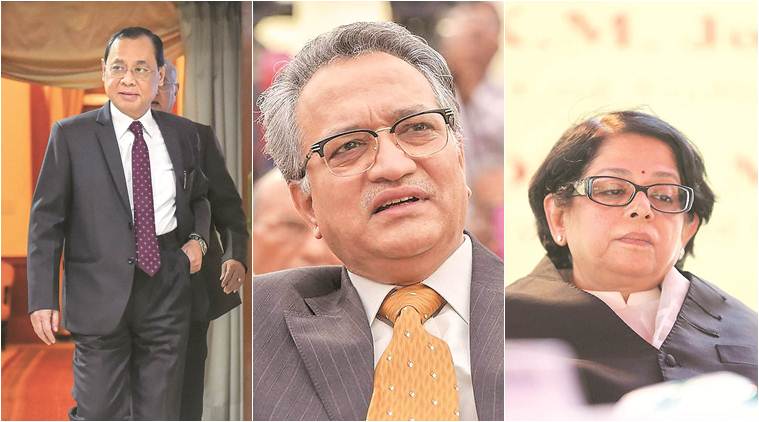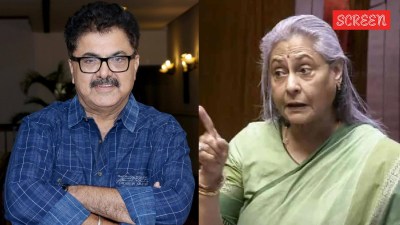Concluding that its September 28, 2018 judgment lifting age restrictions on the entry of women into the Sabarimala hill shrine may impinge on the affairs of other religions too and will require a more detailed examination, the Supreme Court, in a 3-2 decision Thursday, decided that petitions seeking review of the verdict will be kept pending till a larger bench of seven judges takes a call on the matter.
In turning to a larger Bench, three of the five judges on the Constitution Bench — Chief Justice of India Ranjan Gogoi, Justices A M Khanwilkar and Indu Malhotra — sought clarity on issues ranging from the essential religious practice test, including the “apparent conflict” between rulings in the Shirur Mutt case and Durgah Committee, Ajmer; entry into a mosque/durgah by Muslim women and into an agyari by Parsi women married to non-Parsis; the interplay between freedom of religion under Articles 25 and 26 of the Constitution and other provisions in Part III, particularly Article 14; and, the definition of constitutional morality.

While Justices Rohinton F Nariman and D Y Chandrachud gave a dissenting view, Justice Khanwilkar, who had gone with the majority 4-1 verdict in 2018 that lifted age restrictions on entry into Sabarimala, went with the majority decision to seek clarity from a larger bench this time. In the 2018 order, Justice Malhotra was the lone judge with a dissenting view.
Writing the majority judgment for himself and Justices Khanwilkar and Malhotra, CJI Gogoi said the “debate about the constitutional validity of practices entailing into restriction of entry of women generally in the place of worship is not limited to this case, but also arises in respect of entry of Muslim women in a Durgah/Mosque as also in relation to Parsi women married to a non-Parsi into the holy fire place of an Agyari” and “it is time that this Court should evolve a judicial policy, befitting to its plenary powers, to do substantial and complete justice and for an authoritative enunciation of the constitutional principles by a larger bench of not less than seven judges”.
ALSO READ | Sabarimala: To review or not is only narrow question, rest later: The 2 in 3-2
“There is yet another seminal issue pending for consideration in this Court regarding the powers of the constitutional courts to tread on question as to whether a particular practice is essential to religion or is an integral of the religion, in respect of female genital mutilation in Dawoodi Bohra community.”
These, it said, may be overlapping and covered by the 2018 Sabarimala verdict and the issues arising in those cases being referred to a larger bench cannot be ruled out.
Story continues below this ad
These issues would include defining constitutional morality. “The expression ‘morality’ or ‘constitutional morality’ has not been defined in the Constitution. Is it overarching morality in reference to Preamble or limited to religious beliefs or faith? There is need to delineate the contours of that expression, lest it becomes subjective,” the CJI wrote.
The verdict also suggested other issues for likely consideration by the larger bench — the interplay between freedom of religion under Articles 25 and 26 of the Constitution and other provisions in Part III, particularly Article 14; sweep of expression ‘public order, morality and health’ occurring in Article 25(1) of the Constitution; extent to which court can enquire into whether a particular practice is an integral part of the religion or religious practice of a particular religious denomination or should that be left exclusively to be determined by the head of the section of the religious group; the meaning of the expression ‘sections of Hindus’ in Article 25(2)(b) of the Constitution; whether “essential religious practices” of a religious denomination, or even a section thereof are afforded constitutional protection under Article 26, and the permissible extent of judicial recognition to PILs in matters calling into question religious practices of a denomination or a section thereof at the instance of persons who do not belong to such religious denomination.
EXPLAINED | Issues not before this court— 2 who differ in Sabarimala verdict
Pointing out that there was an “apparent conflict” between its judgments in the 1954 Shirur Mutt case, where a seven-judge bench ruled that what are essential religious practices of a particular religious denomination should be left to be determined by the denomination itself, and the 1962 view of a five-judge bench in the Durgah Committee, Ajmer vs. Syed Hussain Ali & Ors “carving out a role for the court in this regard to exclude what the courts determine to be secular practices or superstitious beliefs”, it said this also called for consideration by a larger bench.
Story continues below this ad
“The decision of a larger bench”, it said, “would put at rest recurring issues touching upon the rights flowing from Articles 25 and 26 of the Constitution of India”. Such a decision “indubitably… will also pave way to instil public confidence and effectuate the principle underlying Article 145(3) of the Constitution which predicates that cases involving a substantial question of law as to the interpretation of the Constitution should be heard by a bench of minimum five judges of this Court,” it said.
CJI Gogoi wrote that the requirement of five judges was laid down when the strength of the Supreme Court was only seven judges and the purpose was to ensure that the Court “must rule authoritatively, if not as a full court”.
He said that given the present strength of SC, “it may not be inappropriate if matters involving seminal issues including the interpretation of the provisions of the Constitution touching upon the right to profess, practice and propagate its own religion, are heard by larger bench of commensurate number of Judges. That would ensure an authoritative pronouncement and also reflect the plurality of views of the Judges converging into one opinion. That may also ensure consistency in approach for the posterity”.
He said the larger bench “may also consider it appropriate to decide all issues, including the question as to whether the Kerala Hindu Places of Public Worship (Authorisation of Entry) Rules, 1965” govern Sabarimala temple at all and whether this will require grant of a fresh opportunity to all interested parties.

 From top left: CJI Gogoi, Justices Khanwilkar, Malhotra
From top left: CJI Gogoi, Justices Khanwilkar, Malhotra






